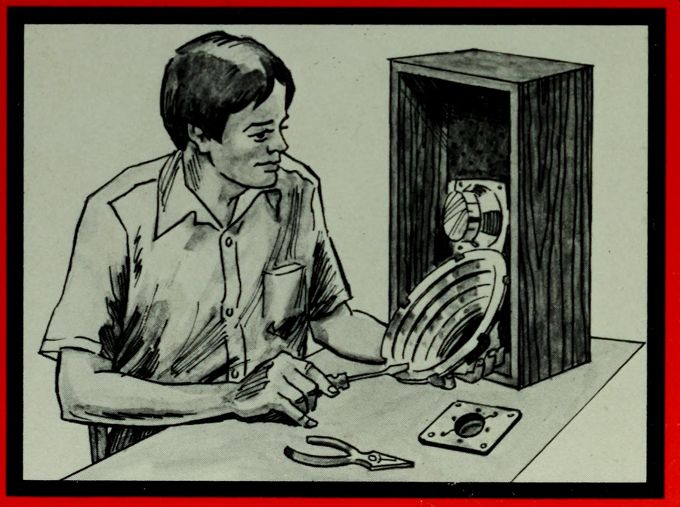AMAZON multi-meters discounts AMAZON oscilloscope discounts

Contents
0. Introduction (this page, below)
Parts of a Speaker-Frequency Response-Transient Response-Dispersion-Cone Resonance-Compliance Damping-Impedance-Efficiency-Power Rating--Speaker Polarity-Kinds of Drivers
2. Kinds of Speaker Enclosures
Functions of Enclosures-Types of Enclosures-Which Enclosure Is Best?-Project 1: A Compact Two-Way Speaker
Desirable Enclosure Characteristics-Enclosure Shape Speaker Placement -Materials-Construction Rules Finishing Your Speakers-More Box Construction Hints Project 2: Designing and Building an Enclosure
Closed Box Basic.--How to Fix Box Volume to Speaker Closed Box Summary-Project 3: A Closed Box System Project 4: An Ultra-Compact Two-Way Speaker
Kinds of Ported Enclosures-How Tuning Affects Response-How Box Volume Affects Response-Thiele Ported Box Design-Fine Tuning by Ear-Project 5: A Ported Box System-Project 6: A Double Chamber Reflex-Project 7: A Compact Ported Box Speaker System
6. Musical Instrument and PA Speakers
Characteristics of Musical Instrument Speakers-Public Ad dress Speakers-Amplifier-Speaker Compatibility-Enclosures for Musical Instrument Speakers-Monitor Speakers-Project 8: A Musical Instrument Speaker
Kinds of Crossover Networks-How to Choose Crossover Frequencies to Match Drivers-Commercial Crossover Networks-Experiments with Multi-Tapped Crossover Networks-A Homemade Crossover Network-How to Make a Choke Coil--L-Pads-Contour Networks Crossover Networks and Piezoelectric Tweeters-Project 9: Three-Way System with 12" Woofer
8. How to Choose and Use Your Speakers
Choosing a Speaker-Size of Speaker vs. Size of Room Musical Tastes-Using Your Speakers-Kind of Wire Terminals-How to Solder-Speaker Placement in the Room-Cabinet Orientation-Protecting Your Speakers Extension Speakers
Listening Tests-FM Hiss Test-Critical Listening-Tests with a Sound Level Meter-Frequency Correction with an Equalizer-Polarity Tests-Damping Test
10. More Projects
Project 10: Two-Way in a Pine Box-Project 11: Extension Speaker-Project 12: Large Woofer Two-Way Speaker Project 13: A Ported System with Special Damping-Project 14: Car Speaker-Project 15: Utility Musical Instrument Speaker-Project 16: PA Speaker
Appendix A Useful Formulas
Appendix B Tests Not Covered in Section 9
Appendix C Wire Data for Homemade Coils
Appendix D Useful Speaker Design Formulas and Procedures
----------------
Introduction
Enclosure shape • Speaker placement • Ported systems • Closed box systems • Musical instrument & P. A. speakers • Car speakers • Crossovers • Materials • Finishing • Testing.
Welcome to the fun of speaker building. This versatile hobby, which has been growing in popularity for several years, combines many different skills. You get a bit of the sciences of electronics and acoustics, as little or as much as you want to dig into those areas. Then there is the practical art of furniture design, if that's your bent. And, of course, the fine art of music appreciation. Speaker building is an endeavor that makes as much use of art as of science.
This guide contains many detailed project plans, from single speaker-in-a-box jobs to two and three-way systems. But, more important to those who like a challenge, you will find practical information on how to design your own system. Simplified design charts make it easy for the novice, but there are calculator and computer programs for those who want to further pursue the design process.
As a home speaker builder, you can design a system that looks and sounds the way you choose, instead of being restricted to what is available from the mass production line of a factory. A manufacturer must appeal to a mass audience; you have only yourself, and perhaps your family, to please.
In talking to many potential speaker builders I have found that the most common reason they have given for holding back is that they doubt their ability to complete a successful project. In almost every case a little encouragement convinced them that their fear was groundless. Many builders have begun with doubts--and ended with success. You can, too.
-------------------
Library of Congress Cataloging in Publication Data: Weems, David B.
Designing, building & testing your own speaker systems--with projects.
Includes index.
1. Loudspeakers--Design and construction-Amateurs' manuals. 1. Title. TK9968.W44. 1984. 621.38'028'2 84-8889 ISBN 0-8306-1 964-X (pbk.) ISBN 0-8306-0964-4 (Radio Shack ed.)
------------------
